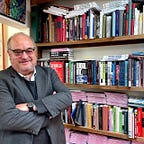One Thousand Years from Today: What will Environmental Social and Governance Issues Look Like in 3022?
In a translation of Boethius’ Consolation made by Alfred the Great about one thousand years ago, the dominant social classes were defined, with robust sexism in tow, as “men of prayer, men of war, and men of work.”
What would this world look like another thousand years from 2022, say by 3022? Many minds examine what social media, technology or taxes might become in those years. Yet few of us think past this century, let alone all of us preoccupied with making the climate commitments to get us past 2050.
But for today, after thinking about how Trump is dead in a series of recent Medium.com entries I’ve written, I want to entertain you with this question about ESG (environmental, sustainability, governance) a thousand years from this market. Will there be many classes or one set of ESG standards? Will prosperity be isolated in a few mega-cities, or also dispersed by technology in 5 by 5G technologies making rural retreats even greater safe havens?
Back in 1020, The Bishop Adalberon of Laon wrote about the social layers seen and felt before him this way:
“The community of the faithful is a single body, but the condition in society is threefold in order. For human law distinguishes two classes: Nobles and Serfs. The former are the warriors and the protectors of churches. They are the defenders of the people, of both great and small, of everyone, and at the same time they ensure their own safety…
“The other class is that of the Serfs. This luckless breed possesses nothing except at the cost of their own labor. Who could, calculating with an abacus, add up the sum of the cares with which the peasants are occupied, of their journeys on foot, of their hard labors? …
“The serfs provide money, clothes and food, for the rest; no free man could exist without the Serfs. And the Serfs never see an end to his tears and his sighs. God’s house, which we think of as one, is thus divided into three; some pray, others fight, yet others work.”
When Karl Marx wrote “Wage, Labour and Capital”, back about 100 years ago, he saw that industrialism had changed the stratification of the world. Marx talked about how capitalism allows those with the means of production to capture and exploit the labor power of the wage owner. I am beginning to see that ESG movements in capital markets are much more egalitarian than both Marx and the Medievals could dream about — -but that matters of the next thousand years are very much up for grabs. Humans are malleable beings, what shall we expect? Will there ever be a time in human history where there are as many winners as losers?
We can laugh when we read this about the past.
Perhaps even enjoy the contrast between the Bishop’s three kinds above with the works of Karl Marx. For we now know clergy as well as civilians, soldiers and well as non-profit peace-keepers, craftsman of financial independence as well as physicians, merchants, advocates, judges, witnesses, prosecutors, pupils, the rich, the idle, the attorneys and accountants, those who think themselves lords of sport and music and entertainment as well as many other specializations. Humans have made the hive have many more cubby holes to them.
We can chuckle and speculate how many of us now have handhelds, better medicines, and decent foot and travel; not all of us, but many of us. Who can render an ESG map of the future? I do not see this vision in the works of Andrew Winston and Paul Polman when they talk about a Net Positive Society? I do not see this vision in most of those writing about ESG today.
Perhaps we need to study social history more than we revel in the behavior of earth spanning multinationals like Pohlmann’s former UNILEVER?
You can measure the past, feel it, and learn. The past was well documented in the 400-page masterwork by Jacque Le Goff, Medieval Civilization: 400 to 1500. You might want to read the brilliant Folio Edition by Umberto Eco to this classic study of social segmentations in the past. It caused me to take pause and offer this reflection about social class.
PRESENT PREDICAMENTS
In order for us to compete in this swift and severe world, I’ve chosen to write in my new book “A New Way to Wealth” about the powers of loyalty, competitive frugality, and friendship. These get us well beyond the stratification of priests, serfs, and soldiers. And that is liberating. To think of the ways, in this new book, each of us can earn agency to change our world, our families and our future.
FUTURE SOLUTIONS
I guess I can think about the next 1000 years because I’ve lived so long. 67 years if magnified by 15 equals roughly 1000 years. So I can extrapolate from my portion of lived experience and imagine a time where we can better align money, people and rules. Perhaps then we will have a natural class, a social capital class, and a leadership class. I think my 19 books have left a record of pointing to this near future.
It’s the end of the world as we know it, and I feel fine.
About me:
I am the founder of www.ahcgroup.com, a Management Consulting firm with multi-year clients like leaders at Merck, bp, and Walgreens Boots Alliance. You can hear a few new radio shows about wellness and the year 2040 at www.doingmorewithlessbook.com.
I would also like to add that I am a husband, a father, and someones neighbor.
